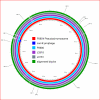Short-term genome evolution of Listeria monocytogenes in a non-controlled environment
- PMID: 19014550
- PMCID: PMC2642827
- DOI: 10.1186/1471-2164-9-539
Short-term genome evolution of Listeria monocytogenes in a non-controlled environment
Abstract
Background: While increasing data on bacterial evolution in controlled environments are available, our understanding of bacterial genome evolution in natural environments is limited. We thus performed full genome analyses on four Listeria monocytogenes, including human and food isolates from both a 1988 case of sporadic listeriosis and a 2000 listeriosis outbreak, which had been linked to contaminated food from a single processing facility. All four isolates had been shown to have identical subtypes, suggesting that a specific L. monocytogenes strain persisted in this processing plant over at least 12 years. While a genome sequence for the 1988 food isolate has been reported, we sequenced the genomes of the 1988 human isolate as well as a human and a food isolate from the 2000 outbreak to allow for comparative genome analyses.
Results: The two L. monocytogenes isolates from 1988 and the two isolates from 2000 had highly similar genome backbone sequences with very few single nucleotide (nt) polymorphisms (1 - 8 SNPs/isolate; confirmed by re-sequencing). While no genome rearrangements were identified in the backbone genome of the four isolates, a 42 kb prophage inserted in the chromosomal comK gene showed evidence for major genome rearrangements. The human-food isolate pair from each 1988 and 2000 had identical prophage sequence; however, there were significant differences in the prophage sequences between the 1988 and 2000 isolates. Diversification of this prophage appears to have been caused by multiple homologous recombination events or possibly prophage replacement. In addition, only the 2000 human isolate contained a plasmid, suggesting plasmid loss or acquisition events. Surprisingly, besides the polymorphisms found in the comK prophage, a single SNP in the tRNA Thr-4 prophage represents the only SNP that differentiates the 1988 isolates from the 2000 isolates.
Conclusion: Our data support the hypothesis that the 2000 human listeriosis outbreak was caused by a L. monocytogenes strain that persisted in a food processing facility over 12 years and show that genome sequencing is a valuable and feasible tool for retrospective epidemiological analyses. Short-term evolution of L. monocytogenes in non-controlled environments appears to involve limited diversification beyond plasmid gain or loss and prophage diversification, highlighting the importance of phages in bacterial evolution.
Figures



References
Publication types
MeSH terms
Substances
LinkOut - more resources
Full Text Sources
Research Materials

